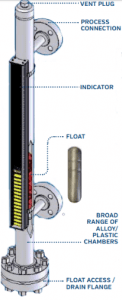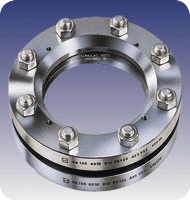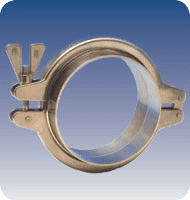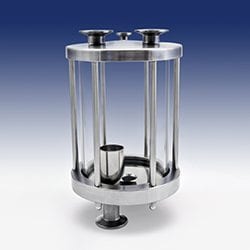LJ Star offers a full line of sight flow indicators to fit any processing application.
What is a Sight Flow Indicator?
A sight flow indicator is a tool used in a variety of processing plants to safely inspect the process material. When installed in process pipelines, sight flow indicators allow visual observation of the direction and rate of flow of liquid, powder, or gas process media, as well as the media’s color and clarity, through one or more observation windows. They consist of a glass column or two opposing windows with a means to mount the device to a pipeline.
What is a Sight Flow Indicator Used For?
The sight flow indicator is used for visual inspection by a human operator in a processing plant. Process fluids must be regularly inspected for characteristics such as clarity, color and foam or to confirm that there is proper flow in the pipeline. Sight flow indicators are also used to visually confirm conditions reported by instrumentation and to provide a backup in case of instrument failure or a power outage.
How Does a Sight Flow Indicator Work?
A sight flow indicator works by providing a window to safely observe the process in a pipeline. The operator is able to clearly see how the process liquid moves through the pipeline and can identify any irregularities that might be present. There are some complexities in the many types of indication and construction of the equipment that need to be considered as each style of indication works a bit differently.
What Are the Different Types of Sight Flow Indicators?
There are multiple types of sight flow indicators available to monitor processing systems. Some applications require a full view indicator, while others need an option that can stand up to more rugged processing conditions. Choosing the right one depends on the application and its specific processing criteria.
View-Through
With two opposing windows, operators can see a backlit fluid flow. These can be used with harsh fluids and high temperatures that some other indicators are not suited for and can be used for the widest range of applications overall.
360° View Flow
This cylindrical flow meter provides a full view while allowing liquid to pass through the tube. Enough light passes through to offer good flow view, which is optimal for observing clarity and color. It is typically used for low-pressure systems with moderate flow rates.
Flapper
Visible through the sight glass, this style features a hinged flapper deflected toward the flow direction, which gives an estimated gauge of the flow. It is usually seen installed on horizontal piping, but vertical pipes with an upward flow can also utilize this type of sight flow indicator.
Drip
To observe drip, this indicator allows for the view of low-volume intermittent flows and drips. With these, gravity is the key driver, and they are used most frequently with vertical pipes with a downward flow.
Rotary Flow
This flow meter is fitted with a rotor that is spun by a gas or fluid flow; it is a rotary flow style. It allows operators to view the direction, along with an approximate speed of the flow
Visual
When an indicator is flapper-style and has a reset spring, it is considered a visual flow meter. The relative flow of the process fluid overcomes the force of the spring and a graduated scale on the glass visualizes the volume.
Ball Flow
A ball is pushed from the indicator’s bottom to the top of the window in this type of sight flow glass indicator. This movement indicates a flow is present in vertical pipes with slow upward flows
How to Select the Proper Sight Flow Indicator
There are many considerations for selecting the ideal sight flow indicator. This online guide walks you through the steps
View Through vs. Full View
A view-through flow indicator has two opposing windows so that an operator can see the intervening flow of fluid lighted from behind. This design is suited for ANSI pressure classes, high temperature, and harsh fluid applications.
360 view is ideal for the observation of process fluid for clarity, color, foam, and other conditions, and for the presence of moisture. Depending on the model it may or may not be suited for high temperatures or pressures.
Type of Indication
Rotary, flapper, flutter, ball, or drip Indicators are available that can help you easily gauge the direction and speed of flow of the process material. Indicators are particularly helpful with colorless gases and opaque fluids.
Mounting Type
The most common mounting methods are flange, threaded, and sanitary clamp. Sanitary clamp mounting is typically used in bio-pharma as well as food & beverage applications. Other options for mounting include orbital weld, Swagelok TS, union, bevel seat, I-line or other specialty connections.
Carbon Steel vs. Stainless Steel
Carbon steel is generally used for industrial applications. Stainless steel offers better corrosion resistance and is standard for pharmaceutical, food & beverage applications.
Gaskets
This doesn’t really affect the selection, as all sight flow indicators are available with a wide variety of gaskets. Just be sure that the gasket material selected is compatible with your process media and temperature requirements.
Type of Glass
Most of our sight flow indicators are available with windows made of either standard soda lime glass (for temperatures below 300◦ F) or borosilicate glass (for temperatures between 300–500◦ F.)
Borosilicate glass is more resistant to thermal shock and caustic than soda lime glass and should be specified in areas where hot equipment may experience washdowns with cool water or corrosive chemicals.
Quartz or sapphire glass is recommended for temperatures greater than 500◦ F, such as in high-temperature steam applications.
Glass can come as a conventional glass disc or as a glass disc fused to a metal ring during manufacturing. Fused sight glass windows, such as our METAGLAS® and MetaClamp® brands, hold the glass in concentric compression that makes the glass resistant to bending stresses that would otherwise cause cracks or failure. They are preferred when high-pressure ratings, impact resistance, thermal shock resistance, and high safety margins are desired.
Subscribe to our Blog
Categories
- Certifications
- Company
- In The News
- Industry Information
- METAGLAS® Sight Glasses
- PackExpo 2020
- Sanitary Clamps
- Sanitary Fittings
- Sight Flow Indicator Benefits
- Sight Glass Applications
- Sight Glass Construction
- Sight Glass Lighting
- Sight Glass Lights
- Sight Glass Process Vessel Camera
- Sight Glasses
- Trade Shows
- Webcast



